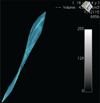Volumetric analysis of syringomyelia following hindbrain decompression for Chiari malformation Type I: syringomyelia resolution follows exponential kinetics
- PMID: 21882909
- PMCID: PMC3731038
- DOI: 10.3171/2011.6.FOCUS11106
Volumetric analysis of syringomyelia following hindbrain decompression for Chiari malformation Type I: syringomyelia resolution follows exponential kinetics
Abstract
Object: Resolution of syringomyelia is common following hindbrain decompression for Chiari malformation, yet little is known about the kinetics governing this process. The authors sought to establish the volumetric rate of syringomyelia resolution.
Methods: A retrospective cohort of patients undergoing hindbrain decompression for a Chiari malformation Type I with preoperative cervical or thoracic syringomyelia was identified. Patients were included in the study if they had at least 3 neuroimaging studies that detailed the entirety of their preoperative syringomyelia over a minimum of 6 months postoperatively. The authors reconstructed the MR images in 3 dimensions and calculated the volume of the syringomyelia. They plotted the syringomyelia volume over time and constructed regression models using the method of least squares. The Akaike information criterion and Bayesian information criterion were used to calculate the relative goodness of fit. The coefficients of determination R(2) (unadjusted and adjusted) were calculated to describe the proportion of variability in each individual data set accounted for by the statistical model.
Results: Two patients were identified as meeting inclusion criteria. Plots of the least-squares best fit were identified as 4.01459e(-0.0180804)(x) and 13.2556e(-0.00615859)(x). Decay of the syringomyelia followed an exponential model in both patients (R(2) = 0.989582 and 0.948864).
Conclusions: Three-dimensional analysis of syringomyelia resolution over time enables the kinetics to be estimated. This technique is yet to be validated in a large cohort. Because syringomyelia is the final common pathway for a number of different pathological processes, it is possible that this exponential only applies to syringomyelia related to treatment of Chiari malformation Type I.
Figures



Similar articles
-
Outcome of Chiari-associated syringomyelia after hindbrain decompression in children: analysis of 49 consecutive cases.Neurosurgery. 2008 Jun;62(6):1307-13; discussion 1313. doi: 10.1227/01.neu.0000333302.72307.3b. Neurosurgery. 2008. PMID: 18824997
-
A points-based algorithm for prognosticating clinical outcome of Chiari malformation Type I with syringomyelia: results from a predictive model analysis of 82 surgically managed adult patients.J Neurosurg Spine. 2018 Jan;28(1):23-32. doi: 10.3171/2017.5.SPINE17264. Epub 2017 Nov 10. J Neurosurg Spine. 2018. PMID: 29125433
-
Cerebellar and hindbrain motion in Chiari malformation with and without syringomyelia.J Neurosurg Spine. 2016 Apr;24(4):546-55. doi: 10.3171/2015.8.SPINE15325. Epub 2016 Jan 1. J Neurosurg Spine. 2016. PMID: 26722953
-
Chiari I malformation associated with syringomyelia and scoliosis: a twenty-year review of surgical and nonsurgical treatment in a pediatric population.Spine (Phila Pa 1976). 2002 Jul 1;27(13):1451-5. doi: 10.1097/00007632-200207010-00015. Spine (Phila Pa 1976). 2002. PMID: 12131745 Review.
-
Definitions and Anatomic Considerations in Chiari I Malformation and Associated Syringomyelia.Neurosurg Clin N Am. 2015 Oct;26(4):487-93. doi: 10.1016/j.nec.2015.06.007. Epub 2015 Aug 4. Neurosurg Clin N Am. 2015. PMID: 26408056 Review.
Cited by
-
The effect of posterior fossa decompression in adult Chiari malformation and basilar invagination: a systematic review and meta-analysis.Neurosurg Rev. 2018 Jan;41(1):311-321. doi: 10.1007/s10143-017-0857-5. Epub 2017 May 2. Neurosurg Rev. 2018. PMID: 28466256
-
Analysis of volumetric response of pituitary adenomas receiving adjuvant CyberKnife stereotactic radiosurgery with the application of an exponential fitting model.Medicine (Baltimore). 2017 Jan;96(4):e4662. doi: 10.1097/MD.0000000000004662. Medicine (Baltimore). 2017. PMID: 28121913 Free PMC article.
References
-
- Aboulker J. Syringomyelia and intra-rachidian fluids. VIII. Normal fluids movements and pathology out rachis. Neurochirurgie. 1979;25(Suppl 1):73–80. (Fr) - PubMed
-
- Aboulker J. Syringomyelia and intra-rachidian fluids. X. Rachidian fluid stasis. Neurochirurgie. 1979;25(Suppl 1):98–107. (Fr) - PubMed
-
- Akaike H. A new look at the statistical model identification. IEEE Transactions on Automatic Control. 1974;19:716–723.
-
- Ball MJ, Dayan AD. Pathogenesis of syringomyelia. Lancet. 1972;2:799–801. - PubMed
Publication types
MeSH terms
Grants and funding
LinkOut - more resources
Full Text Sources
Other Literature Sources
Medical

